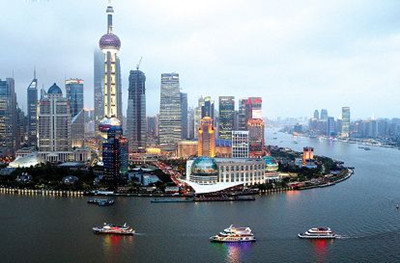自由貿易
Tilted marine
傾斜的海運
New techniques show the damage done by subsidies at the heart of global trade
新方法表明對航運業的補貼具有危害性
THERE is no better symbol of the benefits of globalization than the container ship. More than 9 billion tonnes of goods and materials were transported by sea in 2012, with trade helping to lift global growth rates. An ever-expanding web of links connects rich and poor; developing countries now account for around 60% of seaborne trade. But ships also show the rotten side of trade: protectionism. In 2006 China enacted a “Long and Medium-Term Plan” to enlarge its shipping industry by 2015. It has been successful (see left-hand chart). New research shows its attempts to tilt markets may be having a bigger impact than previously thought.
沒有什么比集裝箱船更能代表全球化帶來的益處。2012年,超過90億噸的物資通過海運運輸,這些貿易加快了全球增長速度。發達地區與貧困地區之間的聯系不斷擴大,如今發展中國家占據了海運貿易的60%。然而,船舶市場依然顯現了貿易的消極一面:保護主義。2006年,中國頒布了一個截至2015年的以鼓勵航運業為目的的“中長期規劃”。這個計劃目前看來是成功的(見左圖)。近期調查顯示,中國試圖傾斜市場的行為可能比想象中更具沖擊力。

Protectionism in shipping is centuries old. In a 1905 study* Royal Meeker, an American economist, explained how a system of subsidies developed under Elizabeth I. Rewards were based on tonnage of ship, and included “bounties” paid to fishing boats heading for the North Sea in search of herring. Adam Smith provided an early economic analysis in “The Wealth of Nations”, lamenting: “It has, I am afraid, been too common for vessels to fit out for the sole purpose of catching, not the fish, but the bounty.” The handouts distorted the shipbuilding industry, resulting in an oversize fishing fleet and a misallocation of resources.
航運業保護主義已經有一百年的歷史了。美國經濟學家羅亞爾·米克在1905年做的一項研究解釋了伊麗莎白一世在任期間的補貼制度是怎樣制定的。補貼是基于船舶噸位確定的,包括對駛往北海捕獲鯡魚的漁船提供的獎金。亞當·斯密在《國富論》中給出了一個早期的經濟分析,他感嘆道:“裝配船舶的唯一目的恐怕不是捕魚,而是為了得到津貼。”救濟金(補貼)扭曲了造船業,引致了捕撈船隊過于龐大、資源配置不當。
Far from avoiding the distortion Smith spotted, governments have been keen to nurture it. The early logic was military. A strong merchant fleet meant lots of boats that could be commandeered during times of war. One way to bolster shipping has been to grant lucrative contracts for postal delivery: Britain's Cunard lines benefited hugely from such a deal in the 1830s. Another method, used by both America and Japan in the early 1900s, was easy finance, in the form of cut-price government loans.
與斯密所倡導的避免市場扭曲理論相悖甚遠,各國政府一直以來都熱衷于提供補貼。早期,對航運業提供補貼被認為可以為軍事服務。一個強大的商船隊意味著戰爭時期可以征用更多的船舶。鼓勵航運業的一種方法是允許簽訂利潤豐厚的郵遞合同:英國的丘納德航運公司在1830年的一筆郵遞交易中獲利甚多。另一種方法是以廉價政府貸款的形式為航運公司提供便捷的融資,這也是19世紀初美國和日本采取的政策。
Modern shipping subsidies are used to build economic heft rather than military might. Governments like shipping due to the knock-on effects of a booming yard. Modern ships are huge (up to 400m long) and include up to 30,000 parts. Assembling them is labour-intensive, and so is making the parts that outside suppliers provide to the shipyards. A recent report by America's Maritime Administration estimated that more than 107,000 people work in the country's heavily protected shipyards. Adding in the companies supporting the yards, and the shops and services that support these workers, the total ran to 400,000, an employment “multiplier” of 4. So, the idea is, by helping shipping a government indirectly supports workers in many other industries.
現在的航運補貼更多的則是為了加強經濟實力,而非軍事力量。各國政府青睞航運業是因為建造船廠能夠帶來一系列連鎖效應。現代船舶船型巨大(可達400米長),可囊括零部件多達3萬個。供應商制造向船廠提供的零部件,以及組裝這些部件都是勞動密集型的工作。根據美國海事局最近做的一份報告估計,超過10.7萬人在政府強烈保護的造船廠工作。加上這些造船廠的供應商,以及這些工人產生的商品和服務消費需求,總共拉動了40萬人的就業,就業乘數為4。因此,這樣一來通過加強航運業,政府間接拉動了其他行業的就業。
Yet economists' views on subsidies have hardened over time. China's policy provides subsidies both for the construction of ships themselves and for the building or expansion of shipyards. These interferences can distort trade, resulting in inefficient production. In deciding whether a subsidy flouts trade rules the World Trade Organisation (WTO) uses a “price gap” approach. The idea is simple: if a country is producing and selling something at a big discount to what others are charging, there is probably something fishy going on.
然而,經濟學家們對政府補貼的態度越來越堅定。中國的政策是同時對建造船舶和建造、擴大船塢提供補貼。這些干預會扭曲貿易,導致生產效率低下。世界貿易組織(WTO)用“價格差”的方法判定一項補貼是否違反貿易規則。道理很簡單:如果一國生產并出售某產品的價格遠低于其他國家的要價,這其中可能就有問題。
Price gaps provide a quick warning system, but are a poor way to judge the full extent of subsidies, according to a 2013 book by Usha and George Haley, of West Virginia University and the University of New Haven. It is a static approach, ignoring how demand for each shipyard's differentiated products varies over time. It also fails to account for variations in efficiency. Whereas Chinese workers may be relatively cheap, large South Korean or Japanese shipyards exploit economies of scale that smaller Chinese yards cannot. The balance of all these factors, in addition to subsidies, should influence a shipyard's costs and prices.
根據烏莎(西弗吉尼亞大學)和喬治·海利(紐黑文大學)在2013年發表的一本書,價格差提供了一個直觀警示機制,但它卻不能很好的判斷補貼的真實程度。價格差是個靜態方法,忽視了每個造船廠的不同產品的需求隨時間的變動。并且它也不能解釋生產效率的變動。雖然中國的勞動力可能相對更廉價,但韓國和日本的大型造船廠相對中國的小型造船廠擁有規模效應。除了補貼,這些因素的綜合作用也影響著造船廠的成本和定價。
Recognising this, a 2014 working paper by Myrto Kalouptsidi of Princeton University provides a new way to spot subsidies and measure their impact. Using detailed quarterly data on factors like a shipyard's age, size, capacity and staffing levels Ms Kalouptsidi estimates cost functions—the relationship between a yard's output and its cost of production—for 192 yards across China, Japan, South Korea and Europe. By analysing data between 2001 and 2012, she can isolate the impact of China's 2006 policy.
鑒于上述原因,普林斯頓大學的學者Myrto Kalouptsidi于2014年在一份研究手稿中提出了一種考察補貼并衡量其影響的新方法。使用造船廠年齡、規模、容量、員工配備水平等因素的詳細季度數據,Kalouptsidi估計出了中國、日本、韓國以及歐洲的192個造船廠的成本函數(造船廠生產的成本與產出之間的關系)。通過分析2001年到2012年的數據,她排除了中國2006年鼓勵航運業的政策的影響。
The results are striking. A simple price-gap approach shows that Chinese ships cost 7.3% less than rivals'. Controlling for quality differences—Chinese ships are seen as lower quality and so should be around 3.5% cheaper, even in the absence of subsidies—gives a 4% gap, hardly justification for WTO rage. But Ms Kalouptsidi's estimates show this is just part of the story. Government help artificially lowered Chinese firms' costs by between 15-20%. The aid will have included explicit subsidies and hidden benefits, such as tolerating losses at state-owned yards. China's market share jumped as the policy was introduced (see right-hand chart).
結果是驚人的。簡單的價格差方法顯示中國船舶的生產成本相對其競爭對手低7.3%。考慮質量差異—中國船舶被認為質量低下,即使沒有補貼也應該便宜將近3.5%—最終產生了4%的價格差,這并不足以讓WTO動怒。但是Kalouptsidi的估測表明,這僅僅是表面現象。政府人為地援助中國企業將成本降低了15%到20%。這些援助包括顯性補貼和隱性福利,例如容許國有造船廠虧損經營。自從這種政策出臺,中國的市場份額顯著躍升。
As in Smith's day, this has shifted resources. By comparing the costs and productivity of the shipyards in her sample, Ms Kalouptsidi forecasts how the market might have developed in the absence of China's subsidies. Her analysis points to a big resource reallocation: absent the meddling, Japan's market share would have been around 30 percentage points higher. Since many South Korean or Japanese yards are more efficient than China's, it means that the true cost of ship production may well have risen. Bloated by subsidy, China's yards have turned out a surfeit of vessels, often poorly matched to customers' demands.
如同在斯密的時代,這種政策轉移了資源。Kalouptsidi女士通過比較她選取的樣本中的不同造船廠的成本和生產率,預測出了在中國不提供補貼的情況下市場的發展狀況。她分析提出了一個大幅變動的資源重置:如果沒有干預,日本的市場份額應該比現在高出大概30%。由于許多韓國和日本的造船廠比中國生產效率更高,這意味著船舶的真實生產成本可能已經抬高了。受到補貼的鼓勵,中國造船廠過度生產,常常與客戶需求不匹配。
All this suggests the WTO and other trade-watchers may need to refine their tools to help identify the full extent of subsidies. Other markets are ripe for this kind of analysis. The global glut of solar panels owes much to protectionism, according to the Hayleys' book. Steel markets are badly distorted by subsidies to producers, says the WTO. Subsidised solar panels being exported aboard subsidised ships made from subsidised steel show just how far those that seek free trade have to go.
這些都表明了WTO和其他的貿易研究者可能需要改進方法,以更好地判斷補貼的嚴重程度。其他市場已經具備使用上述分析方法的條件。根據海利的書,太陽能電池板在全球范圍內的供給過剩是由保護主義造成的。WTO認為,鋼材市場因為生產補貼而嚴重扭曲。用補貼的鋼材建造補貼的船舶,運輸出口補貼的太陽能電池板,看來那些追求自由貿易的人還有很長一段路要走。












